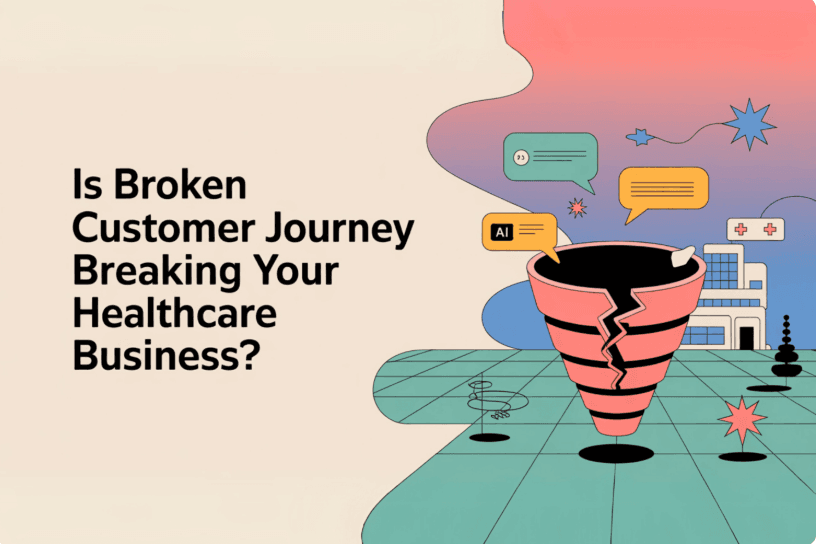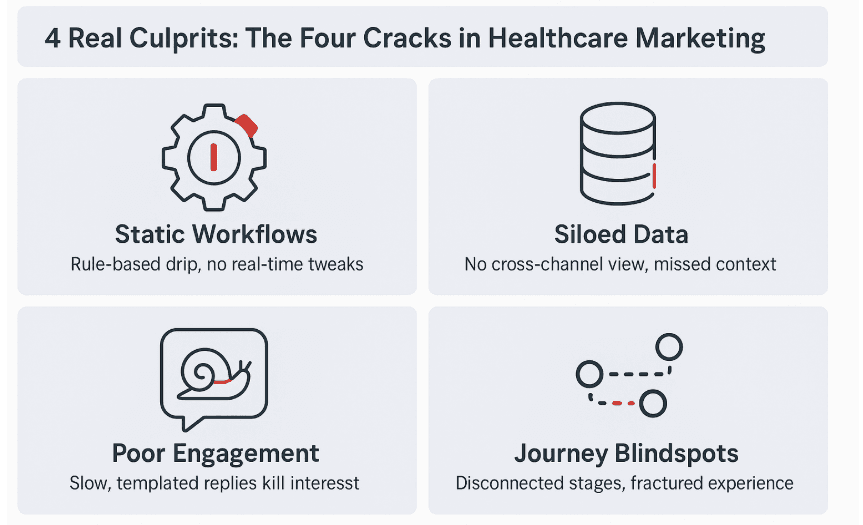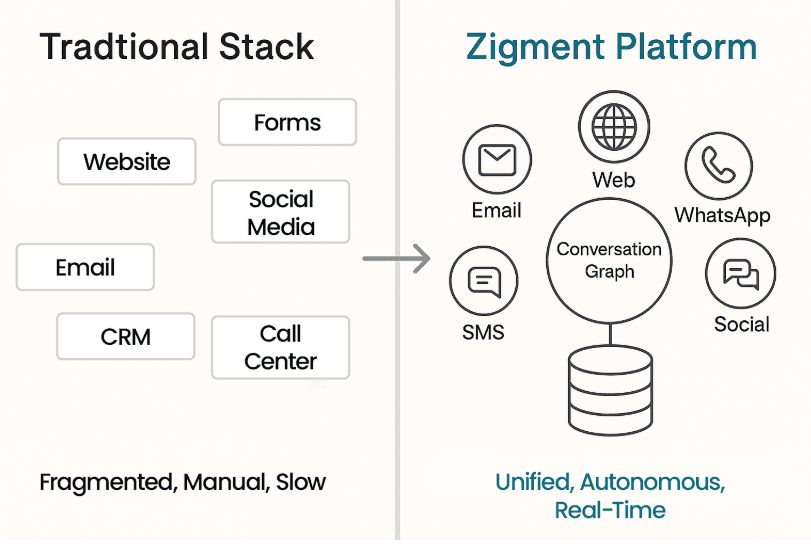How Broken Marketing Funnels and Data Silos Are Costing Indian Healthcare Providers

In an era where patients expect seamless digital experiences and on-demand access, many healthcare providers in India are still grappling with outdated marketing systems that barely keep up. Hospitals and clinics invest crores in digital outreach, yet see underwhelming results. Leads go cold. Campaigns underperform. Patients fall through the cracks. What’s going wrong?
The truth is, the marketing funnel in most Indian healthcare setups is broken—and the damage is not just operational, but financial. For CMOs, CROs, CIOs, and digital marketing teams, the time has come to re-examine how engagement is orchestrated across touchpoints.
The Funnel is Not Leaking — It’s Shattered
Indian hospitals and healthcare chains, especially those with multi-specialty or multi-location setups, often suffer from fractured patient journeys. Here’s a familiar scenario:
A user clicks on a Google ad for “best cardiologist near me,” lands on a form, fills it, and waits. A few hours—or days—later, a call center agent reaches out. Sometimes they miss the window. Sometimes they call at the wrong time. Sometimes they don’t call at all.
By then, the patient has already moved on.
This pattern repeats across WhatsApp leads, social DMs, missed calls, chatbot inquiries, and appointment forms. The result? Massive drop-offs, wasted ad spend, and a fractured brand perception.
The marketing funnel isn’t just inefficient—it’s fundamentally out of sync with how Indian patients expect to engage today.
The Real Culprits Behind Marketing Inefficiency
Several factors converge to create this systemic problem:
1. Rigid and Static Workflows
Most marketing automations are still built using outdated "drip campaign" logic. These are rule-based systems that can't adapt in real time to changes in user intent. A lead might show interest in dermatology but click on an orthopaedic link next—and the system continues pushing skin-related emails. There’s no intelligence, just inertia.
What’s worse, most workflows rely heavily on manual triggers. A human has to review, tag, or qualify leads before the next step happens. This causes delays and introduces avoidable errors. In a category where patient needs are urgent and emotionally driven, slow responses are fatal to conversion.
2. Siloed Data Across Systems
One tool handles website leads. Another handles WhatsApp responses. A third manages email campaigns. The CRM might have appointment data—but only for offline patients. There's no central view of the customer journey.
Without unified data, insights are partial at best. You can’t tell whether a lead who dropped off last week re-engaged on Instagram today. Marketing teams end up targeting the same person multiple times—or worse, not at all—because the system can’t see across channels.
3. Poor or Delayed Engagement
Patients don’t wait anymore. Whether they’re booking a consultation, asking a query, or comparing hospitals, they expect responses in seconds, not hours. Indian users are now conditioned by Swiggy, Flipkart, and MakeMyTrip—they want speed, clarity, and convenience.
Healthcare, unfortunately, is lagging behind. Responses are often slow, templated, and impersonal. Even basic information like doctor availability, OPD hours, or insurance coverage is routed through call centers instead of being accessible instantly.
This lack of intelligent engagement doesn’t just frustrate patients—it kills conversions.
4. Lack of Journey-Oriented Thinking
Many marketing teams focus on lead acquisition but not on journey orchestration. Once the lead is captured, the process becomes manual, disconnected, and operational. There’s no sense of end-to-end lifecycle automation—from awareness to appointment to post-care engagement.
This means the patient experience is disjointed. For a hospital trying to build trust and brand recall, the absence of continuity can be devastating.

The Business Impact
What does all this cost a healthcare provider? The numbers are staggering:
50–70% of digital leads are never followed up in time, according to internal audits by major hospital chains.
Conversion rates drop by over 90% when the first contact happens beyond 5 minutes after inquiry.
Human-led qualification takes 7–10× more time compared to AI-assisted models used in other industries.
Marketing spends are rising, but without automation and data centralization, ROI is falling year over year.
In short, the inefficiencies aren’t just operational—they’re bleeding revenue every single day.
A Smarter Alternative is Emerging
Some forward-looking healthcare brands in India are starting to rethink their stack. They’re moving away from bloated CRM setups and static campaign tools and towards AI-native platforms that can manage conversations, automate workflows, and unify data in real time.
Zigment, for instance, is an agentic AI platform that enables hospitals to instantly engage every lead across WhatsApp, web, SMS, and social platforms—with autonomous agents that qualify, route, and act without human delay. It replaces traditional workflows with real-time, conversation-aware automation, offering a central “conversation graph” that maps every touchpoint across the journey.
While tools like Zigment are gaining traction, the broader point is this: AI isn’t a luxury anymore—it’s the infrastructure layer modern healthcare marketing requires.
Reimagining the Marketing Stack
Here’s what future-ready marketing in healthcare must look like:
Real-time omnichannel agents that can engage leads 24/7 and respond like trained human reps.
Dynamic workflows that adapt based on real-time behaviour—not just pre-set rules.
Minimal human intervention, especially in high-volume lead qualification, nurturing, and routing.
Final Thoughts
The old stack can’t deliver this. It’s slow, fragmented, and expensive.
Healthcare marketing needs a new brain—and AI might just be the missing piece.

